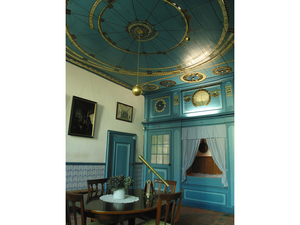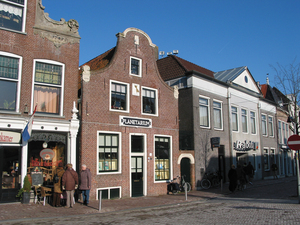Nagoya City Science Museum
TOP > Exhibition Guide > Keyword Search > Starting with "P" > planet > Eise Eisinga Planetarium
Eise Eisinga Planetarium



Purpose of Exhibition
In Franeker, in the north of the Netherlands, is a ceiling orrery built in the 18th century.
This is the Eise Eisinga Planetarium; the word “planetarium” was a newly coined word for it. The mechanical contrivance was designed with the latest astronomical knowledge of those times, and today is still running in the Netherlands. As the name implies, the Eisinga Planetarium is truly the ancestor of the planetariums as we know today, in that it has been dedicated to share the science of astronomy with the public.
This exhibit will show you a full-size replica on the central ceiling of the gallery. Directly below is a diagram with the names of each part translated into Japanese.
Additional Knowledge
When and why Eisinga built his planetarium?
[Eisinga’s Coinage of Planetarium]
The word “planetarium” was coined by combining the word “planet” with the suffix “arium” which means a place to look at something. In short, planetarium is a place to watch planets. It was Eise Eisinga in the Netherlands who first used the word.
On May 8, 1774, an unusual astronomical phenomenon occurred: Mercury, Venus, Mars, Jupiter and the moon were all visible at once in the eastern sky at dawn. Even in those days the science was already able to accurately calculate the positions of the planets and the moon. So, for the intellectual class, it was a rare astronomical event in terms of probability, but not an unnatural omen that would cause a disaster. Meanwhile, the general public had almost no scientific knowledge yet. Newspapers carried false stories that the world was going to end due to the conjunction of the moon and the planets, and which made people uneasy and even upset.
Eise Eisinga, who was thirty years old at the time, felt the need to share his knowledge of astronomy with people. He was a wool carder by trade, not a wealthy man, and with only an elementary school education; he had taught himself to write books on mathematics. He decided that his contribution would be to make an easy-to-understand model of the solar system and spread correct knowledge of the Universe.
After seven years of his determination, Eisinga finally built a model on his living room ceiling, which displays the Sun at the center and Mercury through Saturn in their accurate daily positions. Day after day, it continues to show the planets of the day with the correct astronomical knowledge. He named this facility “Planetarium” as it is a place to watch the planets. He invited the people of the city into his home and showed them the daily movements of the planets. He demonstrated that even if the planets happened to appear in the same direction, it was indeed an uncommon occurrence in the course of the years, but would not lead to the end of the world.
More than 200 years later, the Royal Eise Eisinga Planetarium is completely intact and remains in working order to this day.
The pictures above are: the Eisinga planetarium and the front of the museum.
This page was last edited on 6 July 2022.
Article by Astronomy Section
